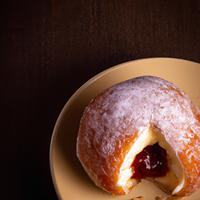
1 serving (100 grams) contains 300 calories, 5.0 grams of protein, 15.0 grams of fat, and 40.0 grams of carbohydrates.

Log this food in SnapCalorie

Nutrition Information
Calories |
714.3 | ||
|---|---|---|---|
% Daily Value* |
|||
| Total Fat | 35.7 g | 45% | |
| Saturated Fat | 11.9 g | 59% | |
| Polyunsaturated Fat | 0 g | ||
| Cholesterol | 71.4 mg | 23% | |
| Sodium | 476.2 mg | 20% | |
| Total Carbohydrates | 95.2 g | 34% | |
| Dietary Fiber | 2.4 g | 8% | |
| Sugars | 47.6 g | ||
| protein | 11.9 g | 23% | |
| Vitamin D | 0 mcg | 0% | |
| Calcium | 47.6 mg | 3% | |
| Iron | 2.4 mg | 13% | |
| Potassium | 119.0 mg | 2% | |
* Percent Daily Values are based on a 2,000 calorie diet. Your daily values may be higher or lower depending on your calorie needs.
Food Attributes
Source of Calories
About Bola de berlim
Bola de Berlim, a beloved treat in Portuguese cuisine, is a deep-fried pastry similar to a Berliner donut. Traditionally filled with a rich egg-yolk-based custard known as "creme de ovos," it boasts a fluffy, airy dough made from flour, sugar, eggs, butter, and yeast. The pastry is typically dusted with powdered sugar, adding to its indulgent nature. While its golden exterior and creamy filling make it a decadent delight, Bola de Berlim isn’t the healthiest option. High in sugar, refined carbs, and fats, it should ideally be enjoyed in moderation as part of a balanced diet. Despite its calorie-dense profile, the custard provides a source of protein due to its egg content. With roots in European baking traditions, this Portuguese favorite is a quintessential comfort food, often enjoyed at beaches and bakeries across the country.



